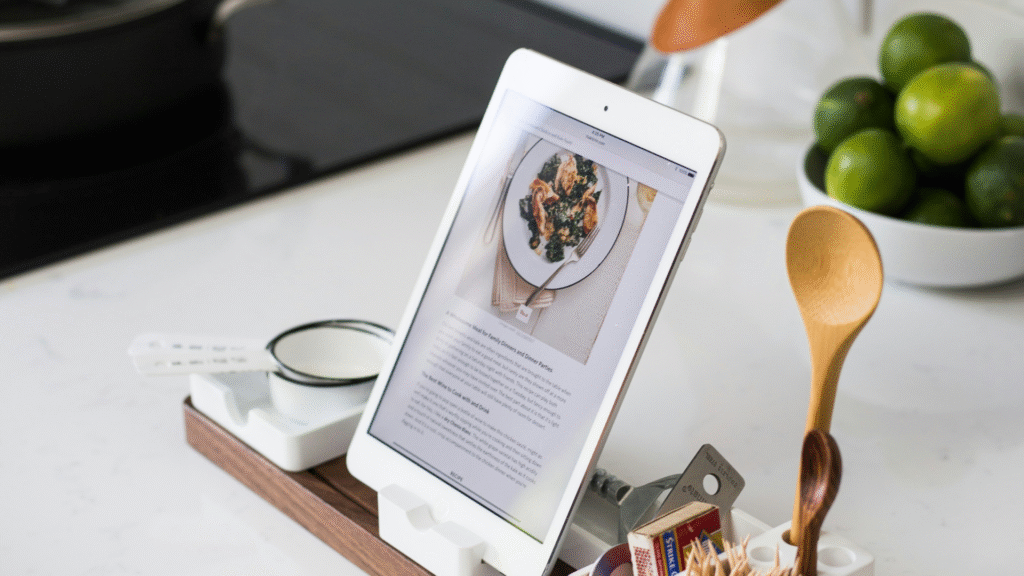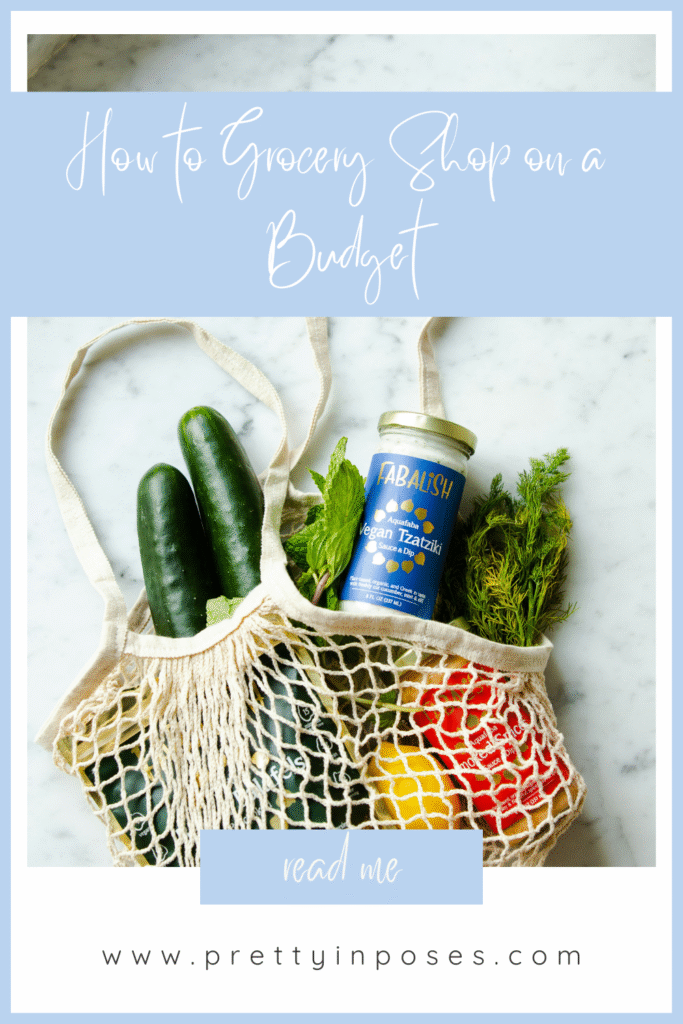This post discusses how to grocery shop on a budget.
I’m what you’d call a “foodie.” I love learning about food, eating it, and preparing my own meals.
So, as you can imagine, I spend more than my fair share of time inside a grocery store, which can get pretty expensive if I’m not careful.
And it’s not just me. The average American family of four spends anywhere from $500 to $1,000 per month on groceries.
Luckily, our wallets don’t have to suffer—there are plenty of simple ways to trim down that weekly food bill.
With that said, I thought it would be helpful to share a few practical tips for how to grocery shop on a budget.
Benefits of Grocery Shopping on a Budget
Any day you can save some money is a good day.
It leaves you with more capital in your pocket to purchase other things you may want or need.
Plus, it helps you become mindful about how you spend your coins which can make you more aware of the food that goes into your body.
You may begin to ask yourself “do I really need that?” and make better food choices because of it.
So, grocery shopping on a budget can stretch your dollar and support healthier eating habits, leading to an overall healthier you.
Grocery Shopping on a Budget
Below are ten simple tips for grocery shopping on a budget. These strategies aren’t just about saving money—they can help improve your entire lifestyle starting today.
Plan Meals Ahead of Time
I like to be super organized when I take on any task—it just makes me feel more productive. Maybe that’s why I’m always talking about planning things out.
But honestly, meal planning is one of the best things you can do before heading to the store. It’s a total game changer for your wallet.
It also gives you more control over what you’re eating and helps cut back on those last-minute takeout runs.
The process is really simple: choose a set number of recipes and the corresponding ingredients you want to have for the week (or month, depending on how you grocery shop).
Make sure to account for leftovers. Write it all down and take that list to the store with you.

Shop With a Grocery List
This basically piggybacks off the first tip. After you’ve made your list, take it with you to the store.
Having a list keeps you focused on what you actually need and helps prevent impulse buys or other wasteful spending.
Try to avoid straying from your meal plan if you can help it.
But if you do end up grabbing something that’s not on your sheet of ingredients, make sure you’ve built in a small cushion for those extra items.
Just cap that part of your list at a certain amount so you don’t accidentally overspend.
Never Shop When Hungry
It’s perhaps one of the most well-known tips for grocery shopping—and for good reason. We’ve all gone into the store for one specific item and come out with things we didn’t really need.
Some of those things were as unhealthy as they were expensive. I’ve definitely gone to the store nearly starving and grabbed a bag of chips to eat in the car—or before I even started the meal.
Eating a small meal or snack before you head out is a smart move because, honestly, we don’t make the best decisions when we’re hungry.
When you start seeing all the quick options available or smell delicious food, it’s easy to stray from your plan.
Use Loyalty Programs & Coupons
I really enjoy loyalty programs and coupons and not just from Ulta, but from many companies, including grocery stores.
These programs often offer discounts, digital coupons, and even cashback rewards for repeat shoppers.
Most of them just ask for your phone number, email, or maybe your zip code. They’re pretty great! I’ve gotten a lot of products basically for free by taking advantage of them.
Other times, I’ve saved anywhere from a few cents to a couple of dollars which can really add up.

Buy in Season
Maybe you’ve seen my post on seasonal eating—or maybe not—but this is another great hack. And it’s not just good for your wallet; it’s great for your nutrition, too.
Produce that’s in season is usually fresher, tastier, and a whole lot cheaper than out-of-season options.
Those out-of-season foods tend to be pricier because they often have to be imported.
Choosing your produce by season also keeps your meals interesting, so you’re not eating the same things over and over again.
Buy in Bulk
Certain stores such as Costco, Sam’s Club, and BJ’s Wholesale Club often sell products in bulk which can be a smart way for larger families to save money over the year.
However, it’s best to buy in bulk only when it makes financial sense for you.
Staples like rice, oats, beans, and frozen vegetables tend to be cheaper in bigger quantities, so they’re great items to stock up on.
Just be careful with perishables—only buy what you know you’ll use before they spoil.
Buy Store Brands Instead of Name Brands
One of the real gems of this post, honestly.
If you’re used to tossing name-brand items into your cart and watching your wallet take a hit, consider giving alternatives a try.
Generic or store-brand products often taste just as good—and can be up to 30% cheaper than the name brands.

Check the Unit Prices
This is a big one. Have you ever weighed your produce before tossing it into your basket? If not, maybe it’s time to start.
Paying attention to unit pricing—the cost per ounce, pound, or liter—can be the difference between staying on budget or going over.
Checking unit prices helps you compare similar products, even when packaging sizes vary, so you get the better deal.
For example, I recently grabbed a pack of avocados for almost seven dollars less than if I’d bought them individually. That kind of savings definitely adds up.
Shop on the Perimeter
Most stores are designed to influence how you shop, and grocery stores are no different.
You may have noticed that fresh essentials like fruits, vegetables, dairy, eggs, and meats are usually found around the store’s perimeter.
The aisles in the middle tend to be stocked with processed, packaged, and brand-name products. These items are often lower in nutrition and can be more expensive.
So when you shop, focus on getting most of your food from the perimeter—these are the ingredients you’ll cook at home, giving you more meals per dollar.
The inner aisles are often filled with products high in sugar, salt, or additives and are full of marketing tricks like buy-one-get-one deals that encourage overspending.
Keep a Calculator
Last but definitely not least, bring a calculator with you when you shop. It helps you keep a running total by letting you add each item’s cost as you place it in your cart.
This way, you can see how much you’re spending in real time, stick to your budget, and get a warning when you’re close to your limit.
Using this method can prevent surprises at checkout and gives you a chance to prioritize what you really need.
If carrying a calculator around the store feels weird, try using a shopping list app, your phone’s calculator, or just eyeball it.
I usually estimate and round up prices to keep myself in the ballpark. It works every time, though it does mean you have to keep track mentally, so it’s better for quick or smaller trips.
Grocery Shop Smart Not Harder
Okay, that wraps up our post on how to grocery shop on a budget.
I really wanted to write this one because so many people are looking for ways to save money, especially when it comes to meals.
As a personal trainer, I often hear that cost is a big reason why people struggle to eat healthier.
But hopefully, I’ve shown it’s possible to have your cake and eat it, too (maybe that pun wasn’t the best, but you get the idea).
The point is, there’s no need to choose between health and your wallet. Smart choices can support both.
If you have any questions or comments, please leave them down below or send me a message through my contact page. Until next time… happy grocery shopping!

Special Thanks
Photo by No Revisions on Unsplash
Photo by Jeff Sheldon on Unsplash
Photo by Patrick Tomasso on Unsplash
Photo by Boxed Water Is Better on Unsplash






Leave a Reply